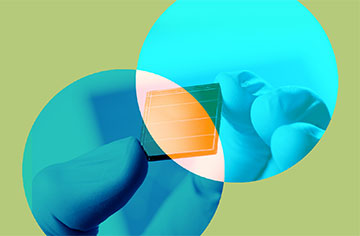
In the latest work, researchers have united two solar technologies to improve both efficiency and stability. [Image: Illustration by Bumper DeJesus]
Perovskite solar cells have attracted a significant amount of commercial interest, thanks to their rapid increase in power conversion efficiency. But perovskite cells have a serious flaw: their susceptibility to voltage-induced changes, which causes the impacted cells and their entire module to degrade when the module is partially obstructed from sunlight.
To overcome this weakness, researchers in the United States and Saudi Arabia decided to connect perovskite solar cells to more traditional silicon ones to create a tandem module (Joule, doi: 10.1016/j.joule.2023.07.017). When the researchers tested the module, they discovered that it is much more resilient than a cell made up of only perovskite. The encouraging results from the tandem cells could improve the commercialization prospects of perovskite cells, the team said in a press release accompanying the paper.
Overcoming partial shading
When overhanging tree branches or other obstructions throw shade on part of a perovskite solar module, the still-illuminated cells can cause a large reverse bias over the now-shaded and inactive cells, degrading both the shaded cells and the entire module within minutes. For a solution to this issue, the researchers looked to tandem solar cells, which have already demonstrated power conversion efficiencies that are greater than those of silicon- or perovskite-only solar cells.
The tandem device showed negligible changes until –10 V, while the silicon-only cell remained resilient with the bias as high as –20 V.
For their experiment, the researchers prepared three different types of solar devices: silicon single-junction, perovskite single-junction and monolithic perovskite/silicon tandem cells. They then blocked the light generated by a solar simulator from reaching one of the cells in each set.
When the researchers performed transient reverse-bias tests with an increasing magnitude of bias on the three devices, they discovered that the perovskite-only cells became unstable when the magnitude of bias was higher than –2.5 V. In contrast, the tandem device showed negligible changes until –10 V, while the silicon-only cell remained resilient with the bias as high as –20 V.
In long-term reverse-bias tests conducted with –2 V for 12 hours, the team found that not only had the perovskite device degraded, but also it had started to degrade after only 10 minutes of testing. On the other hand, both the silicon-only and tandem cells were relatively stable after both –2 V and –15 V tests for 12 hours.
Silicon providing protection and commercial viability
The researchers then decided to investigate the source of resilience in tandem cells. Their simulation revealed that over 95% of the voltage under reverse bias drops in the silicon part of the tandem cells. This is due to the silicon cells’ intrinsic stability against reverse bias, the team wrote, which protects the perovskite section and brings the overall resilience of the tandem devices closer to that of the silicon cells.
“When you combine two different materials to form a final product, usually it’s the weakest link that ends up determining the overall strength of the chain,” said Stefaan De Wolf, a professor of materials science and engineering at the King Abdullah University of Science and Technology (KAUST), Saudi Arabia, in the press release. “But in this case, it’s actually the stronger component that protected the weaker one.”
The team is hopeful that the tandem devices could enhance perovskites’ business potential, as tandem-cell production can be added onto the commercially proven manufacturing process for silicon solar cells.
The team concedes that tandem solar cells still have challenges to overcome, such as their weakness to heat, before they can achieve the ideal lifespan ideal for commercial solar technology. But the team is hopeful that the tandem devices could enhance perovskites’ business potential, as tandem-cell production can be added onto the commercially proven manufacturing process for silicon solar cells.
“If some other stability challenges can be solved, tandem solar cells could essentially take an already successful commercial technology and make it even better,” said Barry Rand, a professor of electrical and computer engineering at Princeton University, USA, in the press release. “Our results make a strong case that tandem devices should be an all-hands-on-deck area for future solar research.”
